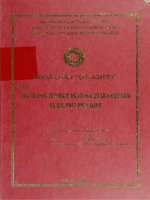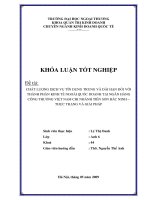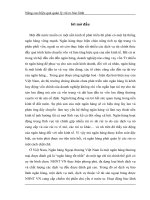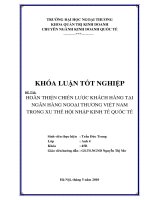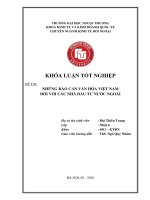Khóa luận tốt nghiệp ngoại ngữ using greeting gestures in america and vietnam – the similarities and differences in light of cross culture communication
Bạn đang xem bản rút gọn của tài liệu. Xem và tải ngay bản đầy đủ của tài liệu tại đây (1.76 MB, 74 trang )
BỘ GIÁO DỤC VÀ ĐÀO TẠO
TRƯỜNG ĐẠI HỌC DÂN LẬP HẢI PHÒNG
-------------------------------
ISO 9001 :2008
KHÓA LUẬN TỐT NGHIỆP
NGÀNH: NGOẠI NGỮ
Sinh viên
: Đỗ Thị Thu Phương
Giảng viên hướng dẫn : Ths.Nguyễn Thị Tố Hoàn
HẢI PHÒNG - 2016
BỘ GIÁO DỤC VÀ ĐÀO TẠO
TRƯỜNG ĐẠI HỌC DÂN LẬP HẢI PHÒNG
-----------------------------------
GRADUATION PAPER
USING GREETING GESTURES IN AMERICA AND
VIETNAM - THE SIMILARITIES AND
DIFFERENCES IN LIGHT OF CROSS – CULTURE
COMMUNICATION
KHÓA LUẬN TỐT NGHIỆP ĐẠI HỌC HỆ CHÍNH QUY
NGÀNH: NGOẠI NGỮ
Sinh viên
: Đỗ Thị Thu Phương
Lớp
: NA1601
Giảng viên hướng dẫn: Ths.Nguyễn Thị Tố Hoàn
HẢI PHÒNG - 2016
BỘ GIÁO DỤC VÀ ĐÀO TẠO
TRƯỜNG ĐẠI HỌC DÂN LẬP HẢI PHÒNG
--------------------------------------
NHIỆM VỤ ĐỀ TÀI TỐT NGHIỆP
Sinh viên: .........................................................Mã SV:....................................
Lớp: .............................Ngành:..........................................................................
Tên đề tài:
......................................................................................................
............................................................................................
............................................................................................
............................................................................................
NHIỆM VỤ ĐỀ TÀI
1. Nội dung và các yêu cầu cần giải quyết trong nhiệm vụ đề tài tốt
nghiệp
( về lý luận, thực tiễn, các số liệu cần tính toán và các bản vẽ).
……………………………………………………………………………..
……………………………………………………………………………..
……………………………………………………………………………..
……………………………………………………………………………..
……………………………………………………………………………..
……………………………………………………………………………..
……………………………………………………………………………..
……………………………………………………………………………..
2. Các số liệu cần thiết để thiết kế, tính toán.
……………………………………………………………………………..
……………………………………………………………………………..
……………………………………………………………………………..
……………………………………………………………………………..
……………………………………………………………………………..
……………………………………………………………………………..
……………………………………………………………………………..
……………………………………………………………………………..
……………………………………………………………………………..
3. Địa điểm thực tập tốt nghiệp.
……………………………………………………………………………..
……………………………………………………………………………..
……………………………………………………………………………..
CÁN BỘ HƯỚNG DẪN ĐỀ TÀI TỐT NGHIỆP
Người hướng dẫn thứ nhất:
Họ và tên:.............................................................................................
Học hàm, học vị:...................................................................................
Cơ quan công tác:.................................................................................
Nội dung hướng dẫn:............................................................................
Người hướng dẫn thứ hai:
Họ và tên:.............................................................................................
Học hàm, học vị:...................................................................................
Cơ quan công tác:.................................................................................
Nội dung hướng dẫn:............................................................................
Đề tài tốt nghiệp được giao ngày
tháng
năm
Yêu cầu phải hoàn thành xong trước ngày
Đã nhận nhiệm vụ ĐTTN
tháng
năm
Đã giao nhiệm vụ ĐTTN
Sinh viên
Người hướng dẫn
Hải Phòng, ngày ...... tháng........năm 2016
Hiệu trưởng
GS.TS.NGƯT Trần Hữu Nghị
PHẦN NHẬN XÉT CỦA CÁN BỘ HƯỚNG DẪN
1. Tinh thần thái độ của sinh viên trong quá trình làm đề tài tốt
nghiệp:
……………………………………………………………………………..
……………………………………………………………………………..
……………………………………………………………………………..
……………………………………………………………………………..
……………………………………………………………………………..
……………………………………………………………………………..
……………………………………………………………………………..
2. Đánh giá chất lượng của khóa luận (so với nội dung yêu cầu đã đề ra
trong nhiệm vụ Đ.T. T.N trên các mặt lý luận, thực tiễn, tính toán số
liệu…):
……………………………………………………………………………..
……………………………………………………………………………..
……………………………………………………………………………..
……………………………………………………………………………..
……………………………………………………………………………..
……………………………………………………………………………..
……………………………………………………………………………..
……………………………………………………………………………..
……………………………………………………………………………..
3. Cho điểm của cán bộ hướng dẫn (ghi bằng cả số và chữ):
……………………………………………………………………………..
……………………………………………………………………………..
……………………………………………………………………………..
Hải Phòng, ngày … tháng … năm 2016
Cán bộ hướng dẫn
(Ký và ghi rõ họ tên)
NHẬN XÉT ĐÁNH GIÁ
CỦA NGƯỜI CHẤM PHẢN BIỆN ĐỀ TÀI TỐT NGHIỆP
1. Đánh giá chất lượng đề tài tốt nghiệp về các mặt thu thập và phân tích
tài liệu, số liệu ban đầu, giá trị lí luận và thực tiễn của đề tài.
.............................................................................................................................
.............................................................................................................................
.............................................................................................................................
.............................................................................................................................
.............................................................................................................................
.............................................................................................................................
.............................................................................................................................
.............................................................................................................................
.............................................................................................................................
2. Cho điểm của người chấm phản biện : ………………………..
(Điểm ghi bằng số và chữ)
Ngày.......... tháng......... năm 2016
Người chấm phản biện
TABLE OF CONTENTS
Acknowledgement
Lists of diagram, figures, charts and tables
PART I: INTRODUCTION ........................................................................ 1
1. Rationale............................................................................................... 1
2. Aims of the study .................................................................................. 2
3. Research questions................................................................................ 2
4. Scope of the study ................................................................................. 2
5. Methods of the study............................................................................. 3
6. Design of the study ............................................................................... 3
PART II: DEVELOPMENT........................................................................ 4
CHAPTER 1: THEORETICAL BACKGROUND ................................. 4
1.1. Culture .............................................................................................. 4
1.2 Communication .................................................................................. 6
1.2.1 Definition of communication........................................................ 6
1.2.2 Classification of communication .................................................. 7
1.2.2.1 Verbal communication ......................................................... 7
1.2.2.2 Nonverbal communication ................................................... 8
1.2.3
Cross-culture communication ................................................. 10
1.3 Body language................................................................................. 11
1.3.1
Definition of body language.................................................... 11
1.3.2
Classification of body language .............................................. 11
1.3.2.1 Facial expressions .............................................................. 12
1.3.2.2 Eye contact......................................................................... 13
1.3.2.3 Physical characteristics....................................................... 13
1.3.2.4 Gestures.............................................................................. 13
1.3.2.5
Postures ............................................................................. 15
1.3.2.4 Body movements................................................................ 16
1.3.2.5 Touching ............................................................................ 16
CHAPTER 2: GREETING GESTURES ............................................... 17
2.1. Greetings ........................................................................................ 17
2.2 Some common greeting gestures in America and Vietnam............... 17
2.2.1 Handshaking .............................................................................. 17
2.2.2 Cheek kissing ............................................................................. 18
2.2.3 Hugging ..................................................................................... 19
2.2.4 Waving arms ............................................................................. 20
2.2.5 Nodding head ............................................................................ 21
2.2.6 Patting ....................................................................................... 22
2.2.7 Smiling....................................................................................... 22
2.2.8 Bowing...................................................................................... 23
2.2.9 High five .................................................................................. 24
2.2.10 V-sign ..................................................................................... 25
CHAPTER 3: DATA ANALYSIS AND COMPARISON..................... 26
3.1 Aim of the survey............................................................................. 26
3.2. Objectives of the survey .................................................................. 26
3.3 Analysis ........................................................................................... 26
3.3.1 Data collection ........................................................................... 26
3.3.2 Analysis ..................................................................................... 26
3.3.2.2 The factors influencing on using greeting gestures ............... 29
3.3.2.3 The influence of the age on using greeting gestures.............. 30
3.3.2.5 The influence of the social status on using greeting gestures 34
3.3.2.6 The influence of relationship on using greeting grestures ..... 36
3.3.2.7 The influence of communication environment on using
greeting gestures .............................................................................. 38
3.3.2.8 The influence of communication situations on using greeting
gestures ............................................................................................ 40
3.4 Making comparison on the use of greeting gestures in Vietnam and
America. ................................................................................................ 42
3.4.1 The similarities........................................................................... 42
3.4.2 The differences........................................................................... 43
PART III: CONCLUSION ........................................................................ 45
1. Summary............................................................................................. 45
3. Recommendation for further study...................................................... 46
REFERENCES........................................................................................... 47
APPENDICES ............................................................................................ 49
Acknowledgement
In the process of doing this study, I have received a lot of help,
assistance, guidance, encouragement and idea contribution from my teachers,
family and friends.
First of all, I would like to express my grateful thanks to Mrs.
Nguyen Thi To Hoan, M.A, my supervisor for her guidance and precious
comments throughout this study. She has helped me so much in choosing the
title of this study and giving me valuable suggestions, advice and detailed
comments about my study.
Secondly, I want to send my sincere thanks to all the teachers of
Foreign Language Department at Hai Phong Private University for their
precious and useful lessons during my four-year study. Especially, I am
profoundly grateful to Mrs. Nguyen Thi Thuy Thu, M.A, my lecturer of the
subject Cross - cultural Communication who has inspired me and provided me
the foundation knowledge in order that I can base on to build my graduation
paper.
Furthermore, I would like to thank all the Vietnamese and American
people in Hai Phong who spent their precious time completing the survey
questionnaires.
Last but not least, I am greatly indebted to my family and friends who
always support me to complete this study.
Hai Phong, June, 2016
Do Thi Thu Phuong
LISTS OF DIAGRAMS, FIGURES, CHARTS AND
TABLES
• Diagrams
Diagram 1: Classification of communication
Diagram 2: Classification of nonverbal Communication
• Figures
Figure 1: The cultural iceberg
Figure 2: Types of facial expressions
Figure 3: Eye contact
Figure 4: Ok sign
Figure 5: Lucky sign
Figure 6: The thumbs-up
Figure 7: The thumbs-down
Figure 8: Sign to say I don’t know
Figure 9: Sign to say I can’t hear
Figure 10: Stop sign
Figure 11: Sign to say I forgot
Figure 12: Handshaking
Figure 13: Kissing
Figure 14: Hugging
Figure 15: Waving arms
Figure 16: Nodding head
Figure 17: Patting
Figure 18: Smiling
Figure 19: Bowing
Figure 20: High Five
Figure 21: V-sign
• Charts
Chart 1: Frequency of using greeting gestures in Vietnam
Chart 2: Frequency of using greeting gestures in America
Chart 3: The influence of the age on using greeting gestures in Vietnam
Chart 4: The influence of the age on using greeting grestures in America
Chart 5: The influence of the gender on using greeting gestures in Vietnam
Chart 6: The influence of the gender on using greeting gestures in America
Chart 7: The influence of the social status on using greeting gestures in
Vietnam
Chart 8: The influence of the social status on using greeting gestures in
America.
Chart 9: The fluence of relationship on using greeting gestures in Vietnam
Chart 10: The influence of relationship on using geeting gestures in American
Chart 11: The influence of communication environment on using greeting
gestures in Vietnam
Chart 12: The influence of communication environment on using greeting
gestures in America
Chart 13: The influence of communication situations on using greeting
gestures in Vietnam
Chart 14: The influence of communication situations on using greeting
gestures in America
• Tables
Table 1: The factors influencing on using greeting gestures in Vietnam and
America
PART I: INTRODUCTION
1. Rationale
Greeting is an important communicative act. Greeting is the first ritual
in communication. It helps us attract the attention, start the communication
process, shorten the distance with the communication partners and create an
atmosphere of open communication. There are two forms of greeting: verbal
and non-verbal greeting. However, in some situations, because of the distance
communication or language barriers, the form of non-verbal greeting is used
more commonly. The form of non-verbal greeting conveys more messages
and it is easier to use than verbal form.
There are various ways of greeting in all over the world. In Western
countries such as France, Spain or Italy, people often greet each other by
hugging or kissing on cheeks, while in the Middle East or Asian countries like
Vietnam, to people of the opposite sex, the ways of kissing or hugging
should be considerated to avoid misunderstanding. If you use improper
greeting rituals, you can cause dilemmas, or even offensive things to your
partner. To make a good first impression with the communication partner, we
need to learn about the greeting cultures of our partner’s country.
Especially to students of English major department who are regularly
in contact with foreign partners or international friends, studying about the
greeting gestures is very important. It helps us avoid vulgar behaviors and
impress the communication partners at the first meeting. This encourages me
to study about greeting gestures in some cultures. All the above reasons have
inspired me to choose the research with the title "Using greeting gestures in
America and Vietnam – The similarities and differences in light of crossculture communication”.
1
2. Aims of the study
As aforementioned, the aim of this study is to compare the similarities
and differences in using greeting gestures in America and Vietnam. Besides,
this study also introduces some common greeting gestures in America and
Vietnam so that people can expand their knowledge of greeting gestures in
two countries. Moreover, the study also gives out some factors influencing on
using greeting gestures in America and Vietnam to people can avoid mistakes,
behave in proper ways, and make an efficient communication when crossing
cultures.
3. Research questions
The study is conducted to answer the following questions:
1. Which greeting gestures are commonly used in America and Vietnam?
2. Which factors do Vietnamese and American people consider when
using greeting gestures?
3. What are the similarities and differences in using greeting gestures in
Vietnam and America?
4. Scope of the study
Greeting gestures are a large theme; in fact, there are so many greeting
gestures in the world. It requires much time and effort; however, because of
the limited time, my knowledge and experience, in this paper, I merely focus
on greeting gestures which are handshaking, hugging, kissing, waving,
nodding, patting, smiling, bowing, high five, V-sign. Moreover, I just
concentrate on two countries: America and Vietnam to compare, from that
you can see the similarities and differences in using gestures and avoid culture
shock in cross-cultural communication.
2
5. Methods of the study
To answer the research questions, a survey questionnaire was conducted to
American and Vietnamese people living in Haiphong city. 30 surveys written
in English were given to American people, 30 surveys written in Vietnamese
to Vietnamese people. There are 60 surveys correspondents being collected.
After that, an in-depth analysis was performed on the collected data.
6. Design of the study
The study contains three parts
- Part I: Introduction presents the rationales, aims, research questions, scope,
methods and design of the study.
- Part II: Consists of three chapters
+ The first chapter is theoretical background which provides readers the
overview of culture, communication and body language.
+ The second chapter talks about greeting and 10 common greeting gestures
in America and Vietnam.
+ The final chapter is data analysis and comparison. In this chapter, I compare
and analyze the findings obtained from the survey questionnaires and
evaluations and after that I point out the similarities and differences in the
using greeting gesture in 2 countries.
- The study is ended with the third part - Conclusion. This part presents an
overview of the study, and recommendations for further study.
3
PART II: DEVELOPMENT
CHAPTER 1: THEORETICAL BACKGROUND
1.1. Culture
The concept of culture appeared very early in human history. The word,
“Culture" comes from French term, which in turn derives from the Latin
"colere" which means care, cultivation and nurture. The concepts of cultures
are more and more developing; however, no one can give an accurate
definition of culture. There are many different definitions of culture. In 1952,
two anthropologists, Alfred Kroeber and Clyde Kluckhohn published a book
with more than 200 pages devoted to different definition of culture; the name
of the book is “Culture: A critical review of concepts and definitions”. After
that, many other scholars offered additional definitions of culture in many
different fields, each definition reflects a different perception and evaluation.
The term was first used by A British anthropologist, Edward B. Tylor. In
his book, Primitive Culture, published in 1871, he said that culture is "that
complex whole which includes knowledge, belief, art, law, morals, custom,
and any other capabilities and habits acquired by man as a member of
society."
Alfred Kroeber and Clyde Kluckhohn (1952:47) also pointed out that
"Culture consists of patterns, explicit and implicit, of and for behavior
acquired
and
transmitted
by
symbols,
constituting
the
distinctive
achievements of human groups, including their embodiments in artifacts; the
essential core of culture consists of traditional (i.e. historically derived and
selected) ideas and especially their attached values; culture systems may, on
the one hand, be considered as products of action, and on the other as
conditioning elements of further action."
4
According to Cambridge English Dictionary Online, culture is, "the way of
life, especially the general customs and beliefs, of a particular group of people
at a particular time."
In Nguyen Quang’s opinion (1998:3), culture is “a share background (for
example, national, ethnic, religious) resulting from a common language and
communication style, custom, beliefs, attitudes, and values. Culture in this
text does not refer to art, music, literature, food, clothing styles, and so on. It
refers to the informal and often hidden patterns of human interactions,
expressions, and viewpoints that people in one culture share. The hidden
nature of culture has been compared to an iceberg, most of which is hidden
underwater! Like the iceberg most of the influence of culture on an individual
cannot be seen. The part of culture that is exposed is not always that which
creates cross-cultural difficulties; the hidden aspects of culture have
significant effects on behavior and on interactions with others.”
Figure 1: The cultural iceberg.
5
In general, all the definitions about culture are just limited directions to
define culture. Culture is even more than all the definitions put together. We
can simply understand that culture includes all of the material and spiritual
products of human being. Culture is created to maintain human society and it
reflects the relationship of the human with the world around so that every
region has its own culture.
1.2
Communication
1.2.1 Definition of communication
According to Hybels (1992:5), “Communication is any process in which
people share information, ideas, and feelings. That process involves not only
the spoken and written word, but also body language, personal mannerisms
and style” and “Communication, then, is vital to our lives. To live is to
communicate”.
Nguyen Quang (1998:3) sees communication as the process of sharing
meaning through verbal and nonverbal behavior.
Communication is defined by Lustig and Koester as “a symbolic,
interpretive, transactional, contextual process in which people create shared
meanings” (2010:13).
Larry A. Samovar, Richard E. Porter and Edwin R. McDaniel (2006:12)
select the all-encompassing definition of “human communication is the
process through which symbols are transmitted for the purpose of eliciting a
response”.
From the definitions above, we can see communication as a process of
exchanging information, ideas, thoughts, feelings and emotions through
speech, signals, writing, or behavior. In communication process, a sender
encodes a message and then using a medium sends it to the receiver who
6
decodes the message and after processing information, sends back appropriate
feedback.
1.2.2 Classification of communication
According to Nguyen Quang communication is divided into verbal
communication and nonverbal communication.
COMMUNICATION
VERBAL COMMUNICATION
NONVERBAL COMMUNICATION
Diagram 1: Classification of communication
1.2.2.1
Verbal communication
Verbal communication refers to the use of sounds and language to relay
a message. It serves as a vehicle for expressing desires, ideas and concepts
and is vital to the processes of learning and teaching.
For example: when a baby says “I’m hungry!". His parents will know that he
wants something to eat.
Verbal Communication is divided into two types: oral communication and
written communication.
Oral Communication is the process of expressing information or ideas by
word of mouth. This can be done by face-to-face conversations, speech,
telephonic conversation, video, radio, television and voice over internet.
Written Communication is a type of interaction that makes use of the
written word. A written message may be printed or hand written. In written
7
communication message can be transmitted via email, letter, report, memo
etc. Written communication is influenced by the vocabulary, grammar,
writing style, precision and clarity of the language used.
1.2.2.2
Nonverbal communication
Nonverbal communication may cover any aspect of communication that
not purely verbal. More precisely, nonverbal communication can be viewed
from two different perspectives (R.F.Verderber. 1990).
From one perspective nonverbal communication refers to people actions or
attributes other than words, J. Burgoon and T. Saine (1978) defined nonverbal
communication as “those attributes or actions of humans, other than the use of
words themselves, which have socially shared meaning, are intentionally sent
or interpreted as intentional, are consciously sent or consciously received, and
have the potential for feedback from the receiver.”
According to Knapp (1972:20), nonverbal communication is term that
describes “all communication events which transcend spoken or written
words”.
In short, we can simply define nonverbal communication as the process of
conveying the information without using words.
There are many classifications of nonverbal communication. Nguyen
Quang (2001:9) presents clearly and easily to understand in the diagram
below:
8
Nonverbal Communication
Paralanguage
- Vocal
characteristics
+ Pitch
+ Volume
+ Rate
+ Vocal
quality
Object language/
Artifacts
- Eye contact
- Clothing
- Setting
- Facial
expressions
- Jewelry
- Conversational
distance/
Proxemics
- Accessories
- Physical
characteristics
- Make-up
- Gestures
- Artifactual
scents
- Postures
- Body
movements
- Vocal
interferences
- Touch/
Haptics/
Tactile
…
Environmental
language
Body language/
Kinesics
- Types of
vocal flow
- Silence
Extralanguage
- Time/
Chronemics
- Gifts
- Lighting
system
- Flowers
- Color
…
- Heat
…
…
Diagram 2: Classification of Nonverbal Communication
9
Nonverbal communication is divided into 2 types: paralanguage and
extralanguage.
Paralanguage concerns how something is said. It is the way we say
something. There are four major categories of paralanguage. They are vocal
characteristics, vocal quality, vocal interferences and silence/pauses.
Extralanguage includes body language, object language and environmental
language.
1.2.3 Cross-culture communication
Samovar & Porter (1997:70) stated that as cultures differ from one
another, the communication practices and behaviours of people will inevitably
vary as a result of their different perceptions of the world. Cross-cultural
communication, more precisely then, is defined as “the study of
communication between people whose cultural perceptions and symbol
systems are distinct enough to alter their communication.”
Nguyen Quang (1998:3) also pointed out that “Communication (verbal or
nonverbal) between people from different cultures; communication that is
influenced and culture values, attitudes and behavior: the influence of culture
on people’ reactions and responses to each other.”
From these definitions we can understand cross-cultural communication is
the communication between people who live in different countries and come
from different cultural background.
Nowadays, companies are expanding their business into global markets,
governments are negotiating across borders and millions of people are
studying and working in countries other than their native ones. Thus, crossculture communication has become more and more essential.
10
1.3
Body language
1.3.1 Definition of body language
According to a definition on Wikipedia “Body language is a kind of
nonverbal communication, where thoughts, intentions, or feelings are
expressed by physical behaviors, such as facial expressions, body posture,
gestures, eye movement, touch and the use of space.”
Another definition of body language is “body language is a
conventional term for communication by the use of parts of the body (other
than the tongue for speaking!). We can analyze it by looking at various parts
of the body isolation, but we must always remember that it is unusual for only
one part of the body to be used at a time. Usually there are ‘clusters’ of
movements involving various parts of the body.” (Beisler et al., 1997)
1.3.2 Classification of body language
Nguyen Quang (2008) stated that there are three main ways to
classifying body language:
• Classification of body language according to their functions:
emblems, illustrators, regulators, adaptors and affect displays.
• Classification of body language according to their origins: universal,
inborn, genetically transferred, group- specific, area-specific, and
culture –specific.
• Classification of body language according to from parts of the body:
facial expressions, eye contact, physical characteristics, gestures,
postures, body movements, and touching.
Because of the limited scope of this study, I would like to focus just only
on types of body language as seen from parts of the body.
11
1.3.2.1
Facial expressions
Charles Darwin, in his 1872 work, The Expression of the Emotions in
Man and Animals, defines that “Facial expression is the process of shaping
the face by muscle contraction responding to principles of emotional
expression”.
According to Beisler et al. (1997), “facial expression involves the
arrangement of facial musles to communicate emotional state or reaction to a
message.”
In general, facial expression is integral when expressing emotions
through the body. Combinations of eyes, eyebrow, lips, nose, and cheek
movements help form different moods of an individual. Facial expression
may be the most precise indicator of a person’s inner feelings, emotions, and
attitudes.
There are six types of facial expressions: happiness, sadness, surprise,
fear, anger, and disgust.
Figure 2: Types of facial expressions
12


